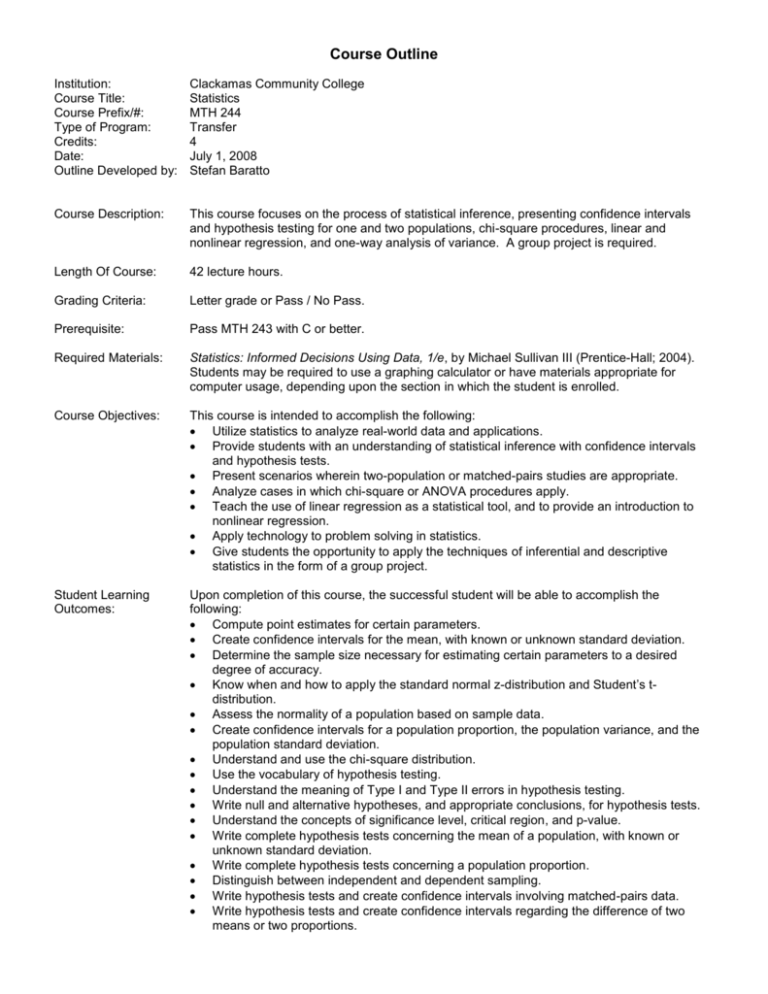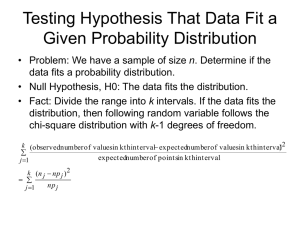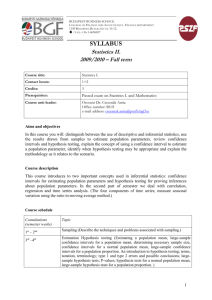Official Course Outline - Clackamas Community College
advertisement

Course Outline Institution: Course Title: Course Prefix/#: Type of Program: Credits: Date: Outline Developed by: Clackamas Community College Statistics MTH 244 Transfer 4 July 1, 2008 Stefan Baratto Course Description: This course focuses on the process of statistical inference, presenting confidence intervals and hypothesis testing for one and two populations, chi-square procedures, linear and nonlinear regression, and one-way analysis of variance. A group project is required. Length Of Course: 42 lecture hours. Grading Criteria: Letter grade or Pass / No Pass. Prerequisite: Pass MTH 243 with C or better. Required Materials: Statistics: Informed Decisions Using Data, 1/e, by Michael Sullivan III (Prentice-Hall; 2004). Students may be required to use a graphing calculator or have materials appropriate for computer usage, depending upon the section in which the student is enrolled. Course Objectives: This course is intended to accomplish the following: Utilize statistics to analyze real-world data and applications. Provide students with an understanding of statistical inference with confidence intervals and hypothesis tests. Present scenarios wherein two-population or matched-pairs studies are appropriate. Analyze cases in which chi-square or ANOVA procedures apply. Teach the use of linear regression as a statistical tool, and to provide an introduction to nonlinear regression. Apply technology to problem solving in statistics. Give students the opportunity to apply the techniques of inferential and descriptive statistics in the form of a group project. Student Learning Outcomes: Upon completion of this course, the successful student will be able to accomplish the following: Compute point estimates for certain parameters. Create confidence intervals for the mean, with known or unknown standard deviation. Determine the sample size necessary for estimating certain parameters to a desired degree of accuracy. Know when and how to apply the standard normal z-distribution and Student’s tdistribution. Assess the normality of a population based on sample data. Create confidence intervals for a population proportion, the population variance, and the population standard deviation. Understand and use the chi-square distribution. Use the vocabulary of hypothesis testing. Understand the meaning of Type I and Type II errors in hypothesis testing. Write null and alternative hypotheses, and appropriate conclusions, for hypothesis tests. Understand the concepts of significance level, critical region, and p-value. Write complete hypothesis tests concerning the mean of a population, with known or unknown standard deviation. Write complete hypothesis tests concerning a population proportion. Distinguish between independent and dependent sampling. Write hypothesis tests and create confidence intervals involving matched-pairs data. Write hypothesis tests and create confidence intervals regarding the difference of two means or two proportions. Major Topic Outline: Perform chi-square goodness-of-fit tests and chi-square tests for independence. Draw and interpret scatter diagrams, and compute and interpret the linear correlation coefficient. Find the least-squares regression line using technology, and interpret the slope and the yintercept. Understand and interpret the coefficient of determination, and analyze residuals. Perform linear and nonlinear regression analysis to determine the line or curve which best fits a sample of ordered-pair data. Test a claim that a linear relation exists between two variables. Compute a confidence interval about the slope of the least-squares regression model. Construct a confidence interval or prediction interval about a predicted value, in the context of linear regression. Conduct a one-way ANOVA hypothesis test. Apply technology to the various tasks involving confidence intervals, hypothesis tests, and regression analysis. Work together with others, in a small-group format, to create an extensive project in which a large raw-data set is analyzed with confidence intervals, hypothesis tests, and statistical plots. Confidence Intervals About a Single Parameter Interval estimation of a population mean, with σ known and with σ unknown; interval estimation of a population proportion; interval estimation of a population standard deviation Hypothesis Testing Testing a hypothesis on the mean, σ known and σ unknown; testing a hypothesis about a population proportion; testing a hypothesis about σ Inferences on Two Samples Inferences about two means, using dependent samples or using independent samples; inferences about two population proportions Chi-Square Procedures Goodness-of-fit test; test for independence; homogeneity of proportions Regression Analysis Simple linear regression; testing a hypothesis for a linear relation; confidence and prediction intervals; nonlinear regression models Analysis of Variance One-way classification Suggested timeline: CLASS HOURS 8 7 5 4 8 2 2 6 42 TOPIC Confidence Intervals About a Single Parameter Hypothesis Testing Inferences on Two Samples Chi-Square Procedures Regression Analysis Analysis of Variance Project Assessments / Final Exam







